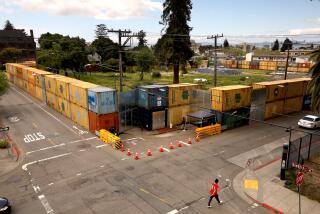Editorial: CEQA was designed to protect the environment, not to fight housing for homeless people
- Share via
Housing for homeless people can’t be built fast enough in Los Angeles to fill the desperate need. So after voters approved Measure HHH to subsidize the construction of 10,000 units of permanent supporting housing, the City Council passed an ordinance to streamline the review process for projects that meet certain criteria. Under the ordinance, developers are allowed to build up to 120 units (and 200 downtown) without conducting an environmental review, provided the projects meet zoning and other requirements. The council also passed an ordinance to speed the conversion of motels into temporary apartments for homeless people.
The efforts to cut red tape, however, have drawn lawsuits by two community groups, which claim that the council’s actions violated the California Environmental Quality Act. The lawsuit contends the city, which did extensive studies of the ordinances’ environmental effects, should have done a much more expansive environmental impact report analyzing the cumulative effects of both measures.
The groups’ legal filings haven’t yet laid out the details of their arguments. But their lawyer, Jamie T. Hall, contended in letters to the city that, among other faults, the city’s study of the housing ordinance underestimated the number of units that it will allow to be built and failed to consider the potential increase in crime. He also claimed that the city ignored “the potential environmental consequences of changes in property values,” citing a 1999 study that found that a supportive housing project in a “highest-value” white neighborhood in Denver had a negative effect on housing prices.
The California Environmental Quality Act was enacted to protect the environment, however, not property values or public safety. Nor is the fear of housing developments for homeless people an environmental issue. As with so many CEQA suits, the real motive here appears to be plain old NIMBYism.
Hall insists that his clients — an organization dubbed Fight Back, Venice and the Oxford Triangle Assn. — are not NIMBYs. However, both groups assert that Venice is taking more than its fair share of proposed homeless housing. There are proposals to put a total of 232 units of homeless housing on two city-owned lots in Venice; neither is eligible for a streamlined environmental review.
An industrious lawyer can find scores of ways to legally use the act as a tool to slow down or stop projects that a community doesn’t like.
Members of Fight Back, Venice — as if the name doesn’t give you a hint — adamantly oppose various proposals for homeless housing, storage and bathroom facilities in Venice, which has one of the area’s highest concentrations of homeless people. (The group’s website accuses Councilman Mike Bonin of building “Skid Row West” and claims the housing ordinance will “strip working families of the legal right to challenge oversized projects.”) The Oxford Triangle Assn., which represents single-family residents in a Venice neighborhood bearing that name, opposes any dense multi-family development on the adjacent Thatcher Yard, a city-owned site where a supportive housing project is set to go up.
A court will decide whether the city has violated CEQA. But an industrious lawyer can find scores of ways to use the act to slow down or stop projects that a community doesn’t like for reasons having nothing to do with their effect on the environment.
The city, for its part, says the environmental studies it conducted for the ordinances were exhaustive and complied with all CEQA regulations. As for the study cited by Hall showing a rise in crime around supportive housing, the residents of the supportive housing were the victims, not the perpetrators.
Meanwhile, other studies show that supportive housing does not lead to an increase in crime rates or necessarily reduce property values. And homeless people who become housed have been shown to use police, fire and emergency services less than when they were homeless. In other words, contrary to Hall’s contention, housing developments for the homeless reduce the drain on city resources.
The supportive housing ordinance is a reasonable and smart measure. More to the point, this is the council instituting a new land use policy, as it has the authority to do. Both disputed ordinances reflect the city government’s goal of encouraging the development of badly needed housing. If community groups continue to parse how many units one neighborhood is taking over another and hire lawyers to twist CEQA to fashion a lawsuit, here is what will happen: Homeless people will be on the streets in tents in their communities for even more years to come.
Follow the Opinion section on Twitter @latimesopinion or Facebook
More to Read
A cure for the common opinion
Get thought-provoking perspectives with our weekly newsletter.
You may occasionally receive promotional content from the Los Angeles Times.










